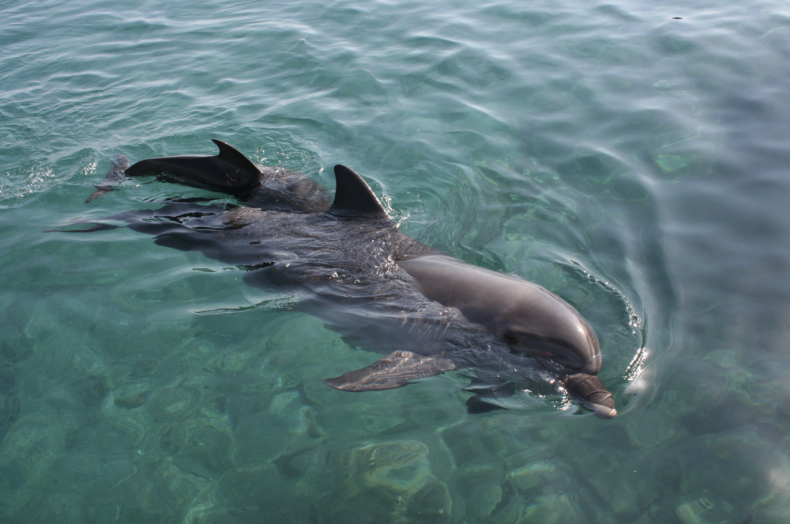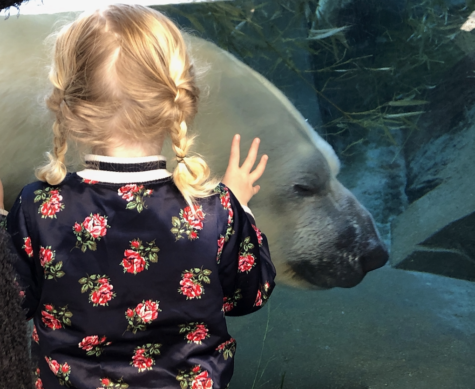
Before my sophomore year of high school, I went to Sea Camp, a week-long summer program in La Jolla, Calif., for (privileged) kids like me who were interested in marine biology. We learned about fish biology during the day. At night, we roasted marshmallows under the stars before falling asleep in our bunks. I was 15. It was amazing.
One day we went to Sea World, that most controversial of theme parks, for a behind-the-scenes tour. I remember being awed by the veterinary tanks and the training pools and the vast volumes of water, into which I stared, hoping to see something dark and moving. Our tour guide was a dolphin trainer.
At one point, we came to a raised holding pool where a newborn bottlenose dolphin, days old, was swimming with its mother. I lay my hand on the side of the pool and pushed up on my toes, trying to get a better view, and both mother and baby swam toward me. They were probably hoping for a fish snack. I was breathless.
I remember this vividly: I looked into the mother dolphin’s eye. I watched her look at me, with a glinting expression that was everything but passive. She was not just looking. She was regarding. Weighing. Thinking. Judging.
This dolphin was intelligent. Of course she was. As this realization settled over me, I was struck that I hadn’t truly known this before. She was a being, not just an animal. I knew this, really knew it, for the first time that day.
I have thought about this experience many times over the years, especially the times when I’ve paid for admission to a zoo attraction or aquarium. God, these places can be depressing! My admission enables their suffering. Doesn’t it? And my admission reminds me that they are suffering, and that they are real, out there, and that they matter. Would I feel their realness — would my daughter? — if all I had were David Attenborough? I truly don’t know.
“People protect what they love, they love what they understand, and they understand what they are taught,” Jacques-Yves Cousteau said. I had this quote taped inside my high school locker. I believe it to my core. My trust in this idea has been the driving force behind my career.
I thought of the mother and baby dolphin again this week, after an essay caught my eye, and my throat. “If Seeing the World Helps Ruin It, Should We Stay Home?” the headline asked.
My friend posted this in a group chat, and I literally sat back and sighed. I don’t know how to answer this question.
Airline travel is a potent source of the emissions that are causing global warming. As the story says, scientists have quantified this potency: One person’s share of carbon dioxide emissions on a 2,5000-mile flight melts 32 square feet of Arctic summer sea ice cover. I ached, reading this.
I grew up flying across the continent, because my dad’s job enabled this. I loved it, and it shaped who I am, in every sense. My dad’s job, together with my mom’s, enabled a very comfortable life — the kind of life that allowed a 15-year-old to fly off to fancy La Jolla for a week to indulge her love of fish and cetaceans.
And it made me brave. It made me confident, and adventurous, and curious. I am the person I am because of the trips my parents gave me, flying with them and without them. Could I give this up? Shouldn’t I? Mustn’t I, when I know that my urge to pack a luggage, traipse through airports, talk to strangers, and eat interesting food is literally hastening the destruction of the ecosystems I love?
Must I?
I think I can’t. I know I won’t. I don’t know how to express my guilt over this. It will gnaw at me. I would buy some carbon offsets, but, well … That is unfortunately not going to help. Please read this vital, depressing story: https://features.propublica.org/brazil-carbon-offsets/inconvenient-truth-carbon-credits-dont-work-deforestation-redd-acre-cambodia/
Travel is vital to me. I went to Europe alone for two weeks this spring, for work, and it will go down as one of the great adventures of my life. I want my daughter to have the same adventures. I want her to travel. I want her to fly.

I haven’t been to Sea World in years, but we do visit the St. Louis Zoo pretty often. Poor Kali, the zoo’s beloved polar bear. He is not made for the heat of our summers. On a recent visit, I watched him swim back and forth, incessantly and desperately, in a pool inside his large, impressive, new, custom-built enclosure. I tried to catch his eye. He would not stop swimming long enough to regard us, or to judge.
“Animals Always,” reads the slogan of our zoo, America’s finest. Always. Despite us, and because of us, in every sense of those words.
–30–
Photo credit: Top, Faraj Meir via Wikimedia Commons/CC 3.0; Side, by author
A question I often wonder: does going to the zoo & aquarium to see the somewhat stir-crazy animals keep us from traveling to & subsequently destroying the wilds where they live? Maybe it’s part of the compromise that keeps too many people from going on safari or a jungle cruise.